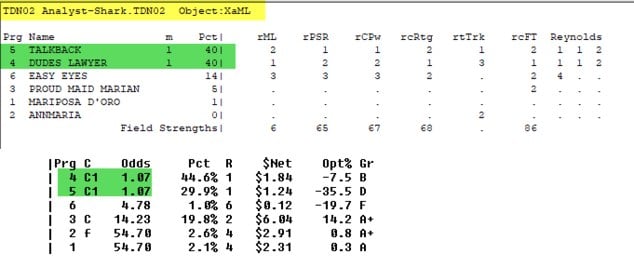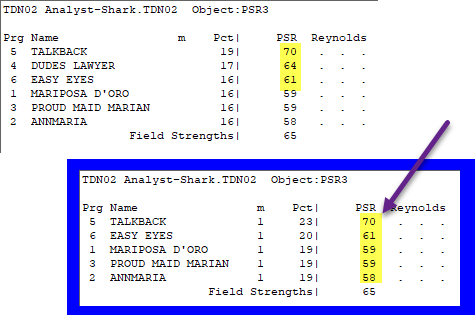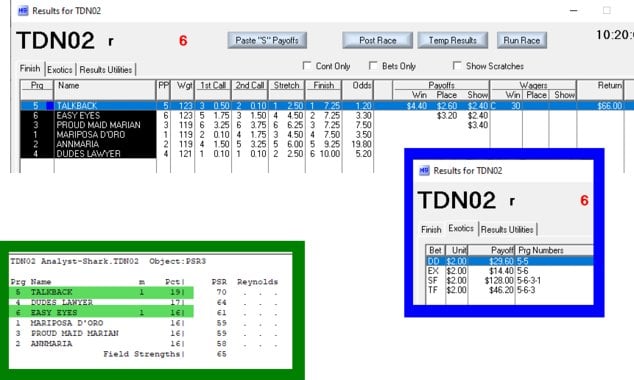-
 Dave Schwartz
421I've got an interesting race for you here.
Dave Schwartz
421I've got an interesting race for you here.

We begin with a double-low-odds race.
BTW, in HSH I refer to horses who project to be 1.21 to 1 or lower as "121 horses."
About 70% of all races have at least one such horse. Only 9-11% have two 121s.
Imagine that you are looking at such a race. The kneejerk reaction of the less-skilled players is to pass such a race, while the winning player is more likely to see it as a race where there are two potential scenarios:
- A dead-bang opportunity to cash an easy winner.
- A dead-bang opportunity for a big score.
_________________________________
LESSON 3: YOU CAN'T DECIDE IF A RACE IS PLAYABLE WITHOUT HANDICAPPING IT.
Many players read the conditions or see a big favorite and say, "Nope. Not for me."
It makes more sense to put in the time to decide if there is a BALO. (Bet Against Low Odds horse)
_________________________________

1. I check to make sure the race really has some early speed horses. (It does.)
2. I check to make sure that the "E" running style is at least 100. (It is.)
The race should have an honest pace.

The Pace-E object tells me that #5 is likely to dominate #4.
Therefore, the #4 is a BALO!
_________________________________
LESSON 4: DO NOT BE AFRAID TO TOSS A LOW-ODDS HORSE BECAUSE HE DOESN'T HAVE EARLY SPEED IN DIRT RACES WITH A MODEL THAT SUPPORTS EARLY!
_________________________________
Let's quickly assess what we know at that point.
- There are two 121 horses.
- Pace Handicapping should tell us the winner.
- One of our 121 horses figures to dominate the early pace.
- We have a BALO.
Recall when I said handicapping is really about asking good questions?
Let's ask a similar set of questions about #5.

Notice that I have removed the BALO (#4) because we believe he's going to be done at the 1st call.
"How does #5 look in terms of the aML object, when compared to the rest of the field?"
Answer: He figures to DOMINATE the field. (62% is the magic number for domination.)

"How does #5 look on the PSR object?"
The top shot shows the conventional approach, which is to include any horse within 1 point of 3rd best.
That gives us 5-4-6, and with the 4 out, that leaves us the 5-6.
The blue box shows us how the race POV changes if we simply take #4 out.
In this case, all the horses are in.
But look at the giant 9-length edge #5 has over the 2nd horse.
One could summarize this by saying, "Either the 5 horse wins, or anybody can win."
_________________________________
LESSON 5: LOOK FOR WAYS TO DESCRIBE SCENARIOS WITH WORDS.
It will be difficult at first, but in the end it will change your understanding of the different scenarios.
Master this, and your results will really improve.
_________________________________

Sure, he was a 6/5 horse, but he won like he was 1/9.
And the green box? Those were the REAL logical contenders. The only horses that fit for PSR were the 5-4-6 and the 4 was a toss. There's your exacta.
_________________________________
KEY POINT:
In this age, there is no single skill that you can master...
that will improve your results...
more than learning to pick winning and losing favorites.
Being able to make a proper assessment of whether a low-odds horse is a good or bad bet is about 80% of the battle. Master that and you'll actually win money for a change.
People think that when you pick low-odds horses you do so because you are not a very good handicapper. After all, you're not smart enough to pick the tough ones, right?
Nothing could be further from the truth.
Let's say that you hang out at a local OTB or you hang with friends online when you play. If you start playing more low-odds horses, in the beginning they tease you about it.
But then, you'll be cashing all those tickets while theirs are being torn up.
After a few days of winning while they lose, you'll see a change in attitude towards you. They will stop the laughing and the joking. Then it will progress to almost angry stares.
Eventually, people will be asking questions like, "What do you think about that 7 horse? Can he get the lead? Can I bet against him?"
How do you suppose I know this? -
 Jack Price
27KEY POINT:
Jack Price
27KEY POINT:
In this age, there is no single skill that you can master...
that will improve your results...
more than learning to pick winning and losing favorites. — Dave Schwartz
Great Stuff.... Dave, thanks for sharing!
For anyone interested, I've attached a one page summary of Dave's 3-part discussion on "Concepts & POV". -
 Dave Schwartz
421I'm going to try to explain using simple statements without a lot of explanation.
Dave Schwartz
421I'm going to try to explain using simple statements without a lot of explanation.
_______________________
When you handicap, your handicapping is based upon a strategy.
The typical strategy of old was:
- Pick Contenders
- Make a line - which is really "make probabilities."
- Bet the overlays.
- This doesn't work any more because the odds change drastically after we've made our bets.
- To make matters worse, this is what the whales do, so if we do this, we're doomed.
I believe the answer is to see different scenarios.
Bye "scenario" I mean a situation.
The following are examples of scenarios.
- One horse in the 1st Tier.
- Two horses in the 1st tier.
- Three plus horses in the 1st tier.
- Odds
- Early Speed
- Contenders
Let's turn those into questions.
- "How many horses are likely to battle for the lead at the 1st call?"
- "How many horses are likely to be well-bet?"
- "How many horses are really contenders?"
So, what I am saying is that those 3 questions, each with 3 possible answers produce 9 different scenarios. (i.e. branches)
Each branch MAY demand a different approach to be successful.
___________________________________________________
LESSON 6: SUCCESSFUL PLAYERS NEED TO HAVE DIFFERENT STRATEGIES TO ADDRESS DIFFERENT SCENARIOS.
___________________________________________________
Please register to see more
Forum Members always see the latest updates and news first. Sign up today.








